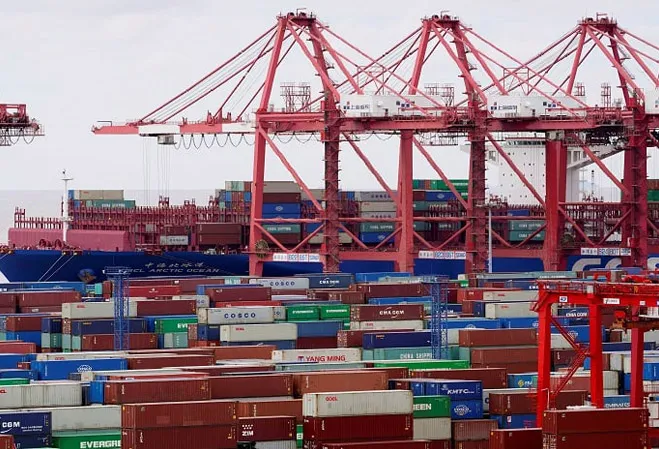
The G20 brings the world’s major economies accounting for more than
80 percent of world GDP and 75 percent of global trade to an international forum. While the world is still dealing with the nightmares of the pandemic, it is confronted with geopolitical havoc. And it is at this juncture that India has assumed the G20 presidency. For the first time in the history of G20, the troika is with the developing world—Indonesia, India, and Brazil. The troika has an opportunity to build a strong and lasting agency for the developing world. How the Indian presidency handles the economic impact of both these crises along with managing the strangled cords of relationships across borders will be quite crucial. India in its presidency has the responsibility to lead the world to economic recovery which is just and equitable. To that end, this paper aims to understand India’s priorities as a G20 president with respect to trade and correcting supply chains.
Recent trade trends in G20
Looking at the import and export trend in services for G20—the growth in exports and imports of services for the
G20 countries were at around 2 percent and 1.1 percent in Q1 2022, respectively. After the downward slump of Q1 2020 and an upturn thereafter till Q1 2021, the growth in the export and import of services in the G20 has been spiralling downward. This slowdown is primarily due to a weaker transport sector in East Asia and general slump in services trade.
G20 Trade in Services
Quarter-on-quarter percentage changes
 Source- OECD, G20 International Trade Statistics, New Release<1>
Source- OECD, G20 International Trade Statistics, New Release<1>Many sanctions were imposed on the export and import of services during the pandemic. The sanctions were removed from exports but the same persists for imports thus causing this slump. Alongside that
36-services trade sanctions were imposed by nine G20 economies on the Russian Federation on services such as transport (air, road or maritime), professional, visa restrictions, and financial services. In response to these sanctions, Russia imposed several countermeasures affecting trade in services.
Furthermore, following severe downturns and upturns in trade in merchandise,
Q1 2022 recorded 3.6 percent and 5.8 percent increase in exports and imports, respectively. This increase is largely owed to a price hike in commodities due to the Russia-Ukraine war and COVID-19 containment measures in East Asia creating further pressure on prices and on already stressed supply chains. Similarly
, 53 trade-restrictive measures were put in place by G20 economies. Thus, it is imperative that India in its G20 presidency must put effort into rolling back the restrictive measures to correct supply chains restrictions caused by the pandemic and the war.
G20 Trade in Goods
Quarter-on-quarter percentage changes
 Source- OECD, G20 International Trade Statistics, New Release
Source- OECD, G20 International Trade Statistics, New Release
However, G20 countries account for majority of current Regional Trade Agreements (RTA). Out of the eight RTAs notified in the six months leading up to 15 May 2022,
seven included at least one G20 economy, while only one includes India—India Australia Free Trade Agreement. India’s experience with trade agreements in the past has been underwhelming, which was one of the reasons why it was wary to join RCEP. However, India has been trying to engage with countries individually. It recently concluded its FTA with the United Arab Emirates (UAE) and Australia. On the sidelines, at the G20 Trade Ministers meeting in 2021, Naples, Italy-
India negotiated trade agreements with the United States (US), United Kingdom (UK), Brazil, European Union (EU), Canada, South Korea, Australia, South Africa, Indonesia, and Mexico.
Furthermore, the below graph is quite telling of the nature of RTAs, especially for the developing countries of the grouping. For most
developing countries trade in goods formed the major part trade agreements. Services sector seems specially reserved for the developed economies. However, services sector is a major contributor for emerging economies like India. Thus, India should continue its efforts for fast tracking the conclusion of much awaited FTAs with EU, and UK. It must also push to include services sector, its area of competitiveness in trade agreements.
G20 RTAs
 Source- OECD, 27th G20 Trade and Investments Report, July 2022
Source- OECD, 27th G20 Trade and Investments Report, July 2022
GVC Correction
There is a heightened need to increase GVC integration to revive the world economy post the pandemic. A study by World Bank shows that by 1 percent increase in GVC participation can increase per capita by more than 1 percent as opposed to .2 percent income increase from traditional trade. Despite efforts towards GVC integration from G20 countries during their presidencies, countries are resorting to unilateralism, geoeconomic fragmentation and protectionism. Geoeconomic fragmentation bears costs. According to a study conducted by International Monetary Fund and World Bank, geoeconomic fragmentation would
lead to fall in world GDP by 1.5 percent. India in its G20 presidency has set greater GVC integration as one its priorities. India envisages to
develop geospatial mapping of global value chains for essential sectors and products, network restructuring and supply chain management solutions to build resilience towards future disruptions. India’s role will also be important in reviving multilateralism. The
trade and investment group (TIWG) is planning to put forward a digital platform for a legal aid system for dispute settlement at WTO aimed at reviving multilateralism and to introducing measures to eradicate non-tariff barriers easing cross-border trade.
Furthermore, across the globe,
about 80-90 percent of the world relies on trade finance. Since the beginning of the pandemic, access to trade finance has become difficult for low- and middle-income countries due to deteriorating sovereign ratings owing to high fiscal pressure. As such, international banks withdrew their credit and confirmation lines.
Multilateral development banks (MDBs) have had to step in to facilitate the flow of essential food and medical supplies to the poorest countries, but they still face excess demand for trade finance. Shrinking trade can inflict enormous damage to the real economy. It is necessary to finance supply chain operations in small and medium enterprises to enable trade. While WTO has identified the concerns about paucity of trade finance for low- and middle-income countries, G20 must re-energise WTO’s efforts for trade financing by intensifying work in its Finance tracks and related working groups. G20 must encourage World Bank and regional development banks such as Asian Development Bank (ADB), Inter-American Development Bank (IDB), and European Bank for Reconstruction and Development (EBRD) to device innovative methods of financing trade operations to correct the supply chain disruptions.
MSMEs in Trade
There has been an increment in the scope and number of regional trade agreements in the past years. The same trend has also transcended to provisions for
MSMEs in these agreements but not enough. The
MSME firms in developed countries account for 78 percent of exporters but only 34 percent of exports. In developing countries, MSMEs' exports amount to only 7.6 percent of total sales, as compared to 14.1 percent for large manufacturing enterprises. As shown in the below graph, in
353 RTAs only 196 RTAs have provisions for MSMEs. The G20 must include more provisions for MSMEs in the forthcoming RTAs, India making sure of that in its awaiting FTAs will engrave this as a practice for future. Also, integrating MSMEs in national economies and international trade has been a priority for many countries in their G20 presidency and it is India’s one of the priority areas as well. India has developed a digital platform,
Open Network for Digital Commerce (ONDC), which connects sellers, buyers, payment processors, and logistics partners in creating an e-commerce marketplace.
Evolution of MSME provisions in RTAs
 Source- WTO<2>
Source- WTO<2>
Conclusion
Amidst the pandemic, war and the dynamic geopolitics, India has multiple priorities related to trade and supply chain corrections that it can take in its helm. The pandemic while creating havoc made countries and economies cognisant of global dependencies to function efficiently. With the increasing scare of the recession, it is imperative that India works towards removal of sanctions, advocate for higher trade finance and MSME trade. With G20 troika being held by the developing countries, India also has the dual responsibility of continuing Indonesia’s good work and creating a strong and a lasting agency for Brazil to take forward. It is a game-changing opportunity when the developing world can play a leading role in bringing back the world economy to pre-pandemic levels through enhanced trade and setting new standard for efficient supply chains.
<1> https://www.oecd.org/sdd/its/International-trade-statistics-Q1-2022.pdf
The views expressed above belong to the author(s). ORF research and analyses now available on Telegram! Click here to access our curated content — blogs, longforms and interviews.



 The G20 brings the world’s major economies accounting for more than
The G20 brings the world’s major economies accounting for more than 



 PREV
PREV


